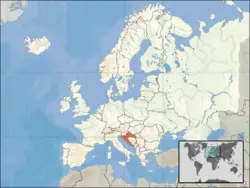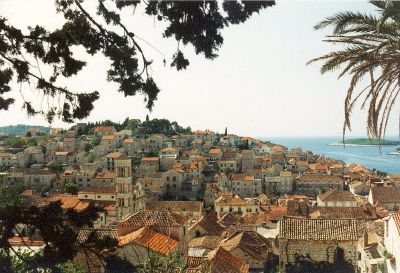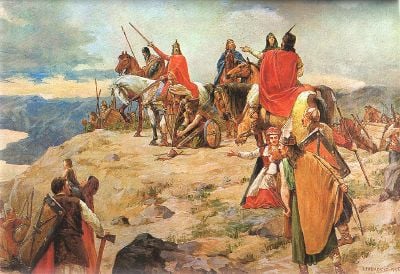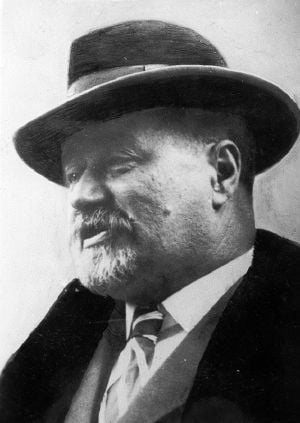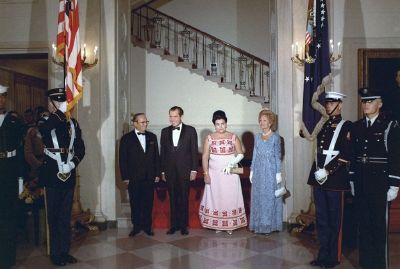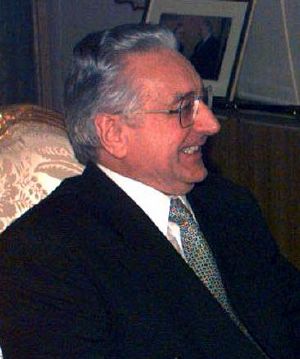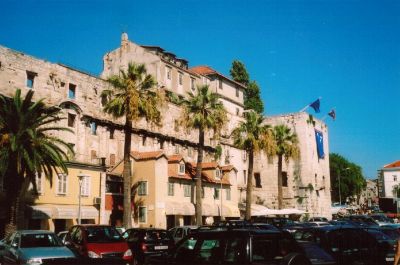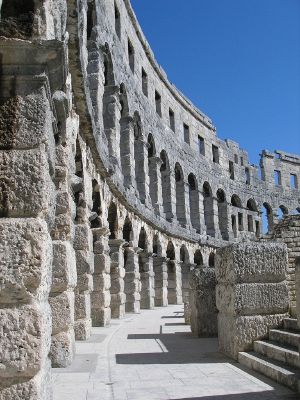Croatia
| Republika Hrvatska Republic of Croatia |
||||||
|---|---|---|---|---|---|---|
|
||||||
| Anthem:¬†Lijepa naŇ°a domovino Our beautiful homeland |
||||||
| Capital (and largest city) | Zagreb 45¬į48‚Ä≤N 16¬į0‚Ä≤E | |||||
| Official languages | Croatian | |||||
| Ethnic groups (2011[1]) | 90.4% Croats 4.4% Serbs 4.4% others 0.8% unspecified |
|||||
| Demonym | Croat, Croatian | |||||
| Government | Parliamentary republic | |||||
| ¬†-¬† | President | Kolinda Grabar-Kitarovińá | ||||
| ¬†-¬† | Prime Minister | Andrej Plenkovińá | ||||
| ¬†-¬† | Speaker of Parliament | Gordan Jandrokovińá | ||||
| Establishment | ||||||
| ¬†-¬† | Principality | 9th century, independent c.‚ÄČ840¬† | ||||
|  -  | Kingdom | 925  | ||||
|  -  | Union with Hungary | 1102  | ||||
|  -  | Joined Habsburg Empire | January 1, 1527  | ||||
| ¬†-¬† | Independence of SHS from Austria‚ÄďHungary | October 29, 1918¬† | ||||
|  -  | Co-founded Kingdom of Serbs, Croats and Slovenes (later renamed Yugoslavia) | December 4, 1918  | ||||
|  -  | Yugoslavia becomes Republic | November 29, 1943  | ||||
|  -  | Decision on independence | June 25, 1991  | ||||
|  -  | Declaration of independence | October 8, 1991  | ||||
| Area | ||||||
|  -  | Total | 56,594 km² (126th) 21,851 sq mi  |
||||
|  -  | Water (%) | 1.09 | ||||
| Population | ||||||
|  -  | 2023 estimate | 4,169,239[1]  | ||||
|  -  | 2021 census | |||||
|  -  | Density | 68.4/km² (152nd) 177.2/sq mi |
||||
| GDP (PPP) | 2023 estimate | |||||
|  -  | Total | |||||
|  -  | Per capita | |||||
| GDP (nominal) | 2023 estimate | |||||
|  -  | Total | |||||
|  -  | Per capita | |||||
| Gini (2022) | 28.5[4]  | |||||
| Currency | Euro (‚ā¨) (EUR) |
|||||
| Time zone | CET (UTC+1) | |||||
|  -  | Summer (DST) | CEST (UTC+2) | ||||
| Internet TLD | .hr | |||||
| Calling code | [[+385]] | |||||
Croatia, officially the Republic of Croatia (Republika Hrvatska), is a strategically important country at the crossroads of the Mediterranean and Central Europe. It controls most land routes from Western Europe to the Aegean Sea, and the Turkish Straits. Croatia shares land borders with Slovenia and Hungary on the north, Serbia on the east, Bosnia and Herzegovina on the south and east, and Montenegro on the south. It borders the Adriatic Sea to the west. Its mainland territory is split in two non-contiguous parts by the short coastline of Bosnia and Herzegovina around Neum.
The country, which by the end of the twentieth century resembled that of a crescent or a horseshoe, has been colonized, invaded, and ruled by numerous different ethnic groups and foreign empires over its 100,000 years of pre-human and human habitation.
Geography
Croatia shares land borders with Slovenia and Hungary on the north, Serbia on the east, Bosnia and Herzegovina on the south and east, and Montenegro on the south. It borders the Adriatic Sea to the west. Its mainland territory is split in two non-contiguous parts by the short coastline of Bosnia and Herzegovina around Neum.
Croatia occupies approximately 21,825 square miles (56,540 square kilometers), or is slightly smaller than West Virginia in the United States.
Its terrain is diverse. There are plains, lakes, and rolling hills in the continental north and northeast (Central Croatia and Slavonia, and part of the Pannonian plain); there are densely wooded mountains in Lika and Gorski Kotar, part of the Dinaric Alps; and there are rocky coastlines on the Adriatic Sea (Istria, northern seacoast and Dalmatia).
The country is famous for its many national parks. Offshore Croatia consists of over one thousand islands varying in size. Seventy percent of the land is farmland. The highest point is Dinara, one of the more prominent mountains located on the border of Croatia and Bosnia and Herzegovina, which is 6000 feet (1830 meters).
Croatia has a mixture of climates. In the north and east it has a continental climate, with hot summers and cold winters. A Mediterranean climate, with mild, rainy winters and warm, dry, and brilliantly sunny summers, prevails along the coast. There is a semi-highland and highland climate in the south-central region. The average temperature in Zagreb is 32¬įF (0¬į C) in January and about 75¬įF (24¬įC) in July. Annual precipitation in Zagreb it is about 26 inches (652mm).
Croatia’s main rivers are the Sava, Drava, Danube and Kupa. The Drava and the Sava flow from the Pannonian Plain into the Danube, which forms part of Croatia’s eastern border with Serbia. The Kupa flows east along the Slovenian border into central Croatia, to join the Sava.
Croatia is rich in mineral resources, which include petroleum, some coal, bauxite, low-grade iron ore, calcium, natural asphalt, silica, mica, clays, salt, and hydropower.
Deciduous forests, including beech and oak, predominate on the plains and in much of the mountainous area, and there are 50 types of protected plant life. The floodplain of the Sava has extensive wetlands that provide a habitat for numerous plant and animal species. Wildlife includes hare, fox, lynx, weasel, otter, bear, deer, marten, boar, wildcat, wolf, and mouflon (wild sheep). Dinara is host to an endemic species of rodents, a vole called "Dinarski miŇ°" ("Dinaric mouse"), which is declared an endangered species.
Natural hazards include destructive earthquakes. Environment issues include air pollution (from metallurgical plants) and resulting acid rain is damaging the forests. Industrial and domestic waste pollution in the rivers became so bad that the water had to be treated even for industrial use. The 1992-1995 civil strife has left a significant number of land mines requiring removal.
Zagreb is the capital and the largest city of Croatia. Zagreb is the cultural, scientific, economic and governmental center of the Republic of Croatia. The city's population in 2001 was 779,145. It is situated between the southern slopes of the Medvednica mountain and both northern and southern bank of the Sava river.
History
The area known as Croatia has been inhabited ever since the Stone Age. In the middle Paleolithic period, Neanderthals lived in the northern area. Bones and other 100,000-year-old remnants of a Neanderthal, subsequently named Homo krapiniensis, were discovered on a hill near the town of Krapina. In the early Neolithic period, the Starcevo-K√∂r√∂s, Vinńća and Sopot cultures were scattered between and around the Sava, the Drava and the Danube rivers. Traces of a somewhat isolated Hvar culture were found on the Adriatic island of Hvar. The Iron Age left traces of the Hallstatt culture (proto-Illyrians) and the La T√®ne culture (proto-Celts).
Illyria and Rome
The area was inhabited by Illyrian tribes such as the Delmetae, who spoke an Illyrian language. King Bardyllis turned Illyria into a formidable power in the fourth century B.C.E. Other tribes such as the Liburni and Iapodes, whose ethnicity is less clear, inhabited various parts of the Adriatic coastline and interior between modern Istria and Herzegovina. [Celts]], the Scordisci tribe colonized the northern parts of modern-day Croatia in the fourth century B.C.E. The islands of Issa and Pharos as well as the locality of Tragurion became Greek colonies since the same period.
Illyria was a sovereign state until the Romans conquered it in 168 B.C.E., and organized the land into the Roman province of Illyricum, which encompassed most of modern Croatia. Illyricum was subsequently split into the provinces of Pannonia and Dalmatia in year 10. Pannonia was further split in two by Trajan between 102 C.E. and 107 C.E.
Christian era
A four-fold split of the same province followed at the turn of the fourth century C.E. under Diocletian ‚ÄĒ an emperor of Illyrian descent, from Dalmatia. Other notable people from these areas in this period included the Christian Jerome, Saint Marinus (builder of San Marino), emperors Valentinian I, Valens, and Pope John IV. After the fall of the Western Roman Empire in the fifth century, the Illyrian population speaking Romance languages (such as Istro-Romanian or Dalmatian) remained. With the increasing amount of human migration, this population became entrenched in the cities along the Dalmatian coast. The Lombards and the Huns made an incursion from the north. After year 476 the area was subject to Odoacer and then to Ostrogoth rulers, beginning with Theodoric the Great. Justinian I claimed the old province of Dalmatia for the Eastern Roman Empire in 535.
Croatian forebears arrive
Forebears of Croatia's Slav population migrated into the Balkans and along the Dalmatian coast in the sixth century, displacing or absorbing the Illyrians. These Slavs encountered other nomadic peoples, including the Avars, Alans, and Antes, and the mixture of these produced the southern Slavs, who remained disparate tribal groups until the ninth century.
Croatian duke Trpimir I (845‚Äď864), founder of the Trpimirovińá dynasty, fought successfully against the Bulgarians, and expanded his state in east to the Drava River. The first native Croatian ruler recognized by a pope was duke Branimir, whom Pope John VIII called dux Chroatorum in 879.
The first King of Croatia, Tomislav (910‚Äď928) of the Trpimirovińá dynasty, was crowned in 925. Tomislav, rex Chroatorum, united the Pannonian and Dalmatian duchies and created a sizeable state. He defeated Bulgarian Tsar Simeon I in the battle of the Bosnian Highlands. The medi√¶val Croatian kingdom reached its peak during the reign of King Petar KreŇ°imir IV (1058‚Äď1074).
Hungarian rule, Ottoman incursions
After defeat in the Battle of Gvozd Mountain, the Croats, in a treaty of 1102, agreed to follow the king of Hungary but retained their own government body, the sabor, and its own governor, or ban. Hungarian rule introduced feudalism and hastened the rise of the native noble families such as Frankopan and ҆ubińá. The later kings sought to restore some of their previously lost influence by giving certain privileges to the towns. The princes of Bribir from the ҆ubińá family became particularly influential, asserting control over large parts of Dalmatia, Slavonia and Bosnia.
Since the twelfth century, Croatia has been largely under the domination of others. The Angevines intervened, restored royal power, and sold the whole of Dalmatia to Venice in 1409. As the Ottoman Empire incursion into Europe started, Croatia once again became a border area. The Croats fought an increasing number of battles and gradually lost increasing swaths of territory to the Ottoman Empire, which, by the sixteenth century, included most of Slavonia, western Bosnia, and Lika.
Habsburg Empire
The 1526 Battle of Moh√°cs and the death of King Louis II of Hungary meant Hungarian rule was replaced by the Austrian Habsburg Monarchy. Later in the same century, large areas of Croatia and Slavonia adjacent to the Ottoman Empire were carved out into the Military Frontier and ruled directly from Vienna military headquarters, creating a buffer zone between Croatia and Austria to the north, and the Ottoman empire to the south. The area became rather deserted and was subsequently settled by Serbs, Vlachs, Croats and Germans and others. Orthodox Slavs who fled Bosnia were moved into the Military Frontier to serve as resident soldiers and were given free title to land. After a fort at Bihańá fell in 1592, only small parts of Croatia remained unconquered. The Ottoman army was repelled for the first time on Croatian soil at the battle of Sisak in 1593. Croatia remained under Hapsburg rule until the late eighteenth and early nineteenth centuries, when Napoleon conquered Croatia in 1809.
Croatian nationalism
Croatian romantic nationalism emerged in mid-nineteenth century to counteract the apparent Germanization and Magyarization of Croatia. This nationalism, known as the Illyrian movement, attracted a number of influential figures from the 1830s on, including Ljudevit Gaj who reformed and standardized the Croatian literary language. Following the revolutions of 1848 in Habsburg areas, and the creation of the dual monarchy of Austria-Hungary, Croatia lost its domestic autonomy, despite the contributions of its ban Josip Jelańćińá in quenching the Hungarian rebellion. Croatian autonomy was restored in 1868 with the Hungarian‚ÄďCroatian Settlement.
Croatia in the First Yugoslavia
After World War I, Croatia joined other southern Slavs in the First Yugoslavia. The Kingdom of Serbs, Croats and Slovenes (the Kingdom of Yugoslavia) was born out of the Treaty of Versailles in 1919. The Croats soon came to resent the Serbian monarch and being governed from Belgrade, the Serbian capital. The Croatian Peasant Party under Stjepan Radińá boycotted the government of the Serbian Radical People's Party. In 1928, the UstaŇ°e (Ustashe) Party was formed to fight for independence, supported by Italy and Germany. In 1928, Radińá was mortally wounded during a Parliament session by PuniŇ°a Rańćińá, a deputy of the Serbian Radical People's Party. In 1929, King Alexander of Yugoslavia proclaimed a dictatorship and imposed a new constitution which, among other things, made Croatia part of the Kingdom of Yugoslavia.
In 1934, King Aleksandar was assassinated in Marseilles by a coalition of two radical groups: the Croatian UstaŇ°e and the Macedonian pro-Bulgarian VMORO. The Serbian-Croatian DragiŇ°a Cvetkovińá-Vlatko Mańćek government that came to power moved closer to Fascist Italy and Nazi Germany in the period of 1935-1941. A national Banovina of Croatia was created in 1939 out of the two banates, as well as parts of the Zeta, Vrbas Banovina, Drina Banovina and Danube banates. It had a reconstructed Croatian parliament which would choose a Croatian ban and viceban. This Croatia included a part of Bosnia (region), most of Herzegovina and the city of Dubrovnik and the surroundings.
World War II
The Axis powers‚Äô occupation of Yugoslavia in 1941 allowed the Croatian radical right UstaŇ°e to come into power, forming the Independent State of Croatia (NDH), led by Ante Pavelińá. Following the pattern of other fascist puppet regime in Europe, the Ustashi enacted racial laws, and formed eight concentration camps targeting minority Roma and Jewish populations. The main targets for persecution, however, where the minority Serbs, who were seen as a trojan horse of Serbian expansionism, and bore the brunt of retribution for the excesses of the Serb royal dictatorship of the First Yugoslavia.
A communist anti-fascist Partisan movement emerged in Croatia early in 1941, under the command of Croat-Slovene Josip Broz Tito. Meanwhile, a Serbian royalist guerrilla group called ńĆetnici (Chetnik) was formed to displace Croats from parts of Bosnia and Herzegovina and Croatia to create a supposedly ethnically "pure" Serb society. The ńĆetnici acted mainly against partisans rather than the occupying fascist forces. It was estimated that hundreds of thousands of people were killed.
By 1943, the partisan resistance movement had gained the upper hand, and in 1945, with the some help from the Soviet Red Army, expelled the Axis forces and local supporters. The ZAVNOH, the state anti-fascist council of people's liberation of Croatia, functioned since 1944 and formed an interim civil government.
Following the defeat of the Independent State of Croatia at the end of the war, a large number of soldiers and civilians (ranging from sympathizers, young conscripts, anti-communists, and ordinary serfs who were motivated by rumours of Partisan atrocities) attempted to flee to Austria hoping to surrender to British forces and be given refuge. They were instead interned by British forces and then returned to the Partisans. Amid conflicting reports, it was estimated that between 35,000 and 55,000 were killed in what has come to be called the Bleiburg massacre.
Second Yugoslavia
Croatia, as a communist republic, became part of the six-part Socialist Federal Republic of Yugoslavia in 1945, which was run by Tito's Communist Party of Yugoslavia. Tito, himself a Croat, adopted a carefully contrived policy to manage the conflicting national ambitions of the Croats and Serbs. Under communism, a Yugoslav identity was promoted and nationalism was suppressed. Singing Croatian songs said to be nationalistic could lead to a jail term. Private property was nationalized and the economy was based on a type of planned market socialism.
The country underwent a rebuilding process, recovered from World War II, went through industrialization and started developing tourism. The constitution of 1963 balanced the power in the country between the Croats and the Serbs, and alleviated the fact that the Croats were again in a minority. Trends after 1965, however, led to the Croatian Spring of 1970‚Äď1971, when students in Zagreb organized demonstrations for greater civil liberties and more Croatian autonomy. The regime stifled the public protest and jailed the leaders, but ratified a new constitution in 1974, giving more rights to the individual republics.
In 1980, after Tito's death, economic, and political difficulties started to mount. Some communist leaders recast themselves as nationalists. Croats began to express resentment against the Yugoslav government. A crisis in Kosovo and, in 1986, the emergence of Slobodan MiloŇ°evińá in Serbia provoked a negative reaction in Croatia and Slovenia. As communist hegemony was challenged throughout Central and Eastern Europe, calls for free multi-party elections were becoming louder.
Croatian war of independence
The Croatian Democratic Union (HDZ) was formed, and Franjo TuńĎman, a former general in Tito's World War II anti-fascist Yugoslav Partisan movement, rose to power. In 1990, the first free elections were held in Slovenia and Croatia. The Croatian Democratic Union (HDZ), led by TuńĎman, won by a slim margin against the reformed communist Social Democratic Party of Croatia (SDP), and Ivica Rańćan, the former president of Croatia's branch of the Yugoslav Communist's League. Tudman‚Äôs party wanted more independence for Croatia, contrary to the wishes of ethnic Serbs in the republic and official politics in Belgrade.
In 1990, Serbs formed an unrecognized Autonomous Region of Serb Krajina (later the Republic of Serbian Krajina). The Yugoslav People's Army, mainly consisting of Serbs, blocked intervention by Croatian police. Croatia declared independence from Yugoslavia on June 25, 1991. The Yugoslav National Army (JNA) attacked Croatian cities, notably Vukovar and Dubrovnik. Civilians fled‚ÄĒthousands of Croats moved away from the Bosnian and Serbian border, while thousands of Serbs moved towards it. The Croatian Parliament cut remaining ties with Yugoslavia on October 8, 1991. At the end of 1991 there was full-scale war in Croatia.
The reasons for the war are complex. Basically, Croatia wanted to separate from Yugoslavia, and Serbs were unwilling to let this happen, largely for economic reasons.
The border city of Vukovar underwent a three month siege ‚ÄĒ the Battle of Vukovar ‚ÄĒ during which most of the city was destroyed and most inhabitants were forced to flee. The city fell to the Serbian forces on November 18, 1991. Subsequent United Nations-sponsored cease-fires followed. The Yugoslav People's Army retreated from Croatia into Bosnia and Herzegovina where the Bosnian War was just about to start. During 1992 and 1993, Croatia handled an estimated 700,000 refugees from Bosnia, mainly Bosnian Muslims.
Armed conflict in Croatia remained intermittent and mostly on a small scale until 1995. In early August, Croatia started Operation Storm and quickly reconquered most of the territories of the Republic of Serbian Krajina, leading to an exodus of the Serbian population. An estimated 90,000-350,000 Serbs fled. A few months later, the war ended with the negotiation of the Dayton Agreement. A peaceful integration of the remaining Serbian-controlled territories in Eastern Slavonia was completed in 1998 under UN supervision. The Serbs who fled from the former Krajina have not returned.
President Tudman died in late 1999. In February 2000, Stjepan Mesińá was elected president, ending the HDZ's rule. The country underwent liberal reforms beginning in 2000. The country started the process of joining the European Union, which was delayed by a perceived lack of co-operation with the International Criminal Tribunal concerning the tracking down of the indicted Gen. Ante Gotovina, who was captured on December 8, 2005.
Government and politics
The politics of Croatia take place in a framework of a parliamentary representative democratic republic, with a pluriform multi-party system. The president (predsjednik) is the head of state, directly elected to a five-year term and is limited by the constitution to a maximum of two terms. The president is the commander in chief of the armed forces, appoints the prime minister with the consent of the parliament, and has some influence on foreign policy. The president‚Äôs official residence is predsjednińćki dvori.
The Croatian parliament (sabor) is a unicameral legislative body. A second chamber, the "House of Counties," which was set up by the constitution of 1990, was abolished in 2001. The number of sabor members can vary from 100 to 160; they are all elected by popular vote to serve four-year terms. The plenary sessions of the sabor take place from January 15 to July 15, and from September 15 to December 15.
The Croatian government (vlada) is headed by the prime minister who has two deputy prime ministers and 14 ministers in charge of particular sectors of activity. The executive branch is responsible for proposing legislation and a budget, executing the laws, and guiding the foreign and internal policies of the republic. The government's official residence is at banski dvori.
Croatia has a three-tiered judicial system, consisting of the Supreme Court, county courts, and municipal courts, and is independent of the executive and the legislature. Court hearings are open, and judgments are mostly made publicly. Judges are appointed by the National Judicial Council, and judicial office is permanent (until 70 years of age). The president of the Supreme Court is elected for a four-year term by the Croatian Parliament at the proposal of the president. The Constitutional Court rules on matters regarding the constitution. Since the 1991‚Äď1995 war, there is increased petty crime, and there are more beggars on the streets. Most are displaced peoples or refugees.
Croatia is divided into 21 counties (Ňĺupanija).
Military
Croatia’s military, Croatian Armed Forces (CAF), consists of ground forces, naval forces, and air and air defense forces, in addition to the Education and Training Command and Support Command. The CAF is headed by the General Staff, which reports to the defense minister, who in turn reports to the president. According to the constitution, the president is the commander-in-chief of the armed forces.
Compulsory conscription was abolished in January 2008. Until 2008, military service was obligatory for men at age 18 and conscripts served six-month tours of duty, reduced in 2001 from the earlier scheme of nine months. Conscientious objectors could instead opt for eight months of civilian service.
Foreign relations
Croatia has established diplomatic relations with 194 countries. 56 foreign embassies and 67 consulates operate in the country, in addition to offices of international organizations such as the European Bank for Reconstruction and Development (EBRD), International Organization for Migration (IOM), Organization for Security and Co-operation in Europe (OSCE), World Bank, World Health Organization (WHO), International Criminal Tribunal for the former Yugoslavia (ICTY), United Nations Development Programme (UNDP), United Nations High Commissioner for Refugees (UNHCR), and UNICEF.
Croatia is a member of NATO. Croatia is a member of the European Union. On January 1, 2023, Croatia simultaneously joined both the Schengen Area and the Eurozone, having previously joined the ERM II on July 10, 2020.
Economy
In an economy traditionally based on agriculture and livestock, peasants comprised more than half of the Croatian population until after World War II. Pre-1945 industrialization was slow and centered on textile mills, sawmills, brickyards, and food-processing plants. Rapid industrialization and diversification occurred after World War II. Decentralization came in 1965, allowing growth of certain sectors, like the large tourist industry. Profits from Croatian industry were used to develop poorer regions in the former Yugoslavia. This, coupled with austerity programs and hyperinflation in the 1980s, led to discontent in both Croatia and Slovenia that fueled the independence movement.
Before the dissolution of Socialist Federal Republic of Yugoslavia, the Republic of Croatia, after Slovenia, was the most prosperous and industrialized area, with a per capita output perhaps one-third above the Yugoslav average. Privatization under the new Croatian Government had barely begun when war broke out. As a result of the Croatian War of Independence, the economic infrastructure sustained massive damage in the period 1991-1992.
By the end of the 1990s, Croatia faced considerable economic problems stemming from:
- the legacy of long-time communist mismanagement of the economy;
- damage during the internecine fighting to bridges, factories, power lines, buildings, and houses;
- the large refugee and displaced population, both Croatian and Bosnian
- the disruption of economic ties; and
- mishandled privatization.
Inflation and unemployment rose and the Croatian kuna fell, prompting the national bank to tighten fiscal policy. A new banking law passed in December 1998 gave the central bank more control over Croatia's 53 remaining commercial banks. Croatia is dependent on international debt to finance the deficit. Western aid and investment, especially in the tourist and oil industries, helped restore the economy.
The death of President Franjo Tudman in December 1999, and the defeat of his ruling Croatian Democratic Union or HDZ party in parliamentary and presidential elections in January 2000 ushered in a new government committed to economic reform and halting the economic decline. The Ivica Rańćan government carried out a large number of structural reforms and with tourism as the main factor, the country emerged from recession in 2000. Due to overall increase in stability, the economic rating of the country improved and interest rates dropped. As a result of coalition politics and resistance from the unions and the public, many reforms are still overdue, especially in the legal system.
Since the end of the communist regime, state-owned property has been transferred to private ownership. There have been difficulties with homes confiscated by the government and occupied by people other than their former owners for long periods of time. The occupants of government-owned apartments have the option to buy their homes. Government-owned industries have been transferred to private ownership.
Export commodities include transport equipment, textiles, chemicals, foodstuffs, and fuels. Export partners included Italy, Bosnia and Herzegovina, Germany, Slovenia, and Austria. Import commodities include machinery, transport, and electrical equipment; chemicals, fuels and lubricants; and foodstuffs. Import partners include Italy, Germany, Russia, Slovenia, Austria 5.8 percent, China, and France.
Demographics
The majority of inhabitants are Croats, around 90 percent. There are around 20 minorities, Serbs being the largest one, with others having less than 0.5 percent each.
Croatia has no official religion. Freedom of religion is a constitutional right that protects all religious communities as equal before the law and separated from the state. The majority of Croatians identify as Christian, of which Catholics make up the larges group.
Language
The official and common language, Croatian, is a South Slavic language, using the Latin alphabet. Less than 5 percent of the population cites other languages as their mother tongues. The Croatian language has three dialects. From 1945 to 1991, the official language was Serbo-Croatian, although Croats often referred to their language as Croato-Serbian. Croatian and Serbian forms of the language have different dialects, and different alphabets. Since independence, Croatian and Serbian have been declared separate languages. Croatian and related Southern Slav languages are modern forms of the languages of the Slavic peoples who migrated into the region around 500 C.E. Under the Habsburgs, urban Croats spoke German, and Latin was the official language of government.
Men and women
Rural women traditionally worked with men on the farm, prepared meals, processed food for storage, kept the house, did laundry, and cared for the children. Under the communist regime, women were encouraged into the workforce, and most women continue to expect to have a job or career. Grandfathers traditionally spend time with grandchildren, and fathers help raise children. Gender differences are more apparent among farmers and the working classes than among professionals.
Marriage and the family
Couples arrange their own marriages, and have usually developed a serious relationship before they meet each other's families. People of the same nationality, religion, educational level, and social status tend to marry. Most marry in their early twenties, monogamy is the rule, divorce is increasingly common, and pregnancy before marriage is not uncommon.
While three-generation households were the norm, young people increasingly want privacy. A housing shortage means young married couples live with parents or a grandparent. Resident grandparents care for small children, although day care and kindergartens are available. The elderly are cared for at home, although nursing homes are available. Traditionally, only sons inherited, and daughters were given a dowry. By the twenty-first century, usually one child in a family inherits the family home, in which he or she lives, while family wealth is distributed equally among all the sons and daughters. Infants are cared for at home, mainly by the mother.
Education
Pre-school, primary, and secondary education is free and available to all. Primary and lower secondary education between the ages of six and 15 is compulsory. Secondary education after 15 is optional. Individuals who do not plan to go to university usually attend a secondary school to prepare for work. Secondary curricula include college preparatory general education, technical education (mechanical training), and specialized education (bookkeeping or office skills).
People value higher education. The republic has 61 institutions of higher education, including four universities located in Zagreb (founded 1669), Split (1974), Rijeka (1973), and Osijek (1975), and three polytechnic institutes. There are also a number of scientific institutes, including the Institute "RuńĎer BoŇ°kovińá" in Zagreb that excels in physics, or the Energy Institute "Hrvoje PoŇĺar" also in Zagreb. The Croatian Academy of Sciences and Arts in Zagreb is a learned society promoting language, culture, and science from its first conception in 1836.
The Roman Catholic Church was instrumental in the founding of many educational facilities in Croatia. The Church continues to maintain numerous seminaries and theological faculties in the country, as well as the Pontifical Croatian College of Saint Jerome for Croatian students in Rome.
Class
There was traditionally an unofficial class system based on one's family name and professional status rather than wealth, but this was superseded by Communist Party membership during the communist era. Since then, material wealth, such as a house or apartment in a city, an automobile, a vacation house, and international travel, indicates status. City dwellers have higher status than people from villages. Croatian and Jewish families are likely to have high status, while Albanians are at the bottom of the social system, and Gypsies are outside it.
Culture
Croatia has a long artistic, literary, and musical tradition. UNESCO has marked six places in Croatia as World Heritage Sites: The Euphrasian Basilica in Poreńć, the cathedral of Saint Jacob in ҆ibenik, the historic city of Trogir, the historic complex of Split with the Palace of Diocletian, the old city of Dubrovnik, and Plitvice Lakes. Croatia also has a place in the history of clothing as the origin of the necktie (cravat).
Architecture
One of Croatia‚Äôs best Roman architectural remains is Diocletian's Palace, built in Split, by the emperor Diocletian between the third and the fourth century C.E. The original town of Split was built around the palace. Another well-known Roman relic is the well preserved amphitheatre in Pula, Istria. The Euphrasian Basilica in Poreńć was built, during the period of Bishop Euphrasius, from 553, over the site of an older basilica, which dated back to the fourth century. The basilica contains some beautiful Byzantine wall mosaics.
The Adriatic islands contain over 13 centuries of Croatian architectural history. Croatian coastal towns contain a mixture of Romanesque, Renaissance and Baroque architecture. There are numerous less glamorous traditional stone houses with red tiled roofs along the Adriatic coast, standing along with architectural gems of the past and the modern hotel complexes of the late twentieth century.
Trogir has a preserved castle and tower and a series of dwellings and palaces from the Romanesque, Gothic, Renaissance and Baroque periods. Trogir's grandest building is the church of Saint Lawrence, whose main west portal is acclaimed as the most significant work of the Romanesque-Gothic style in the country. The best preserved fortified medieval towns are Korcula and Dubrovnik. The islands of Hvar and Korcula were both Venetian naval strongholds and at different times housed the Venetian Arsenal.
Art
Croatian paintings date from the eleventh century. The movement of Croatian Naive Art, or self-taught artists, is Croatia's twentieth century contribution to the world of fine arts. Notable artists from this group include Ivan Lackovic-Croata, Ivan Generalic and Ivan Rabuzin. The most famous Croatian sculptor is Ivan Mestrovic (1883-1962), who created the wooden Madonna and Child. His sculptures can be found in town squares throughout Croatia.
Cuisine
Mainland cuisine is more characterized by the earlier proto-Slavic and the more recent contacts with Hungarian, Viennese and Turkish cuisine, while the coastal region bears the influences of the Greek, Roman and Illyrian, as well as of the later Mediterranean cuisine - Italian and French. A large body of books bears witness to the high level of gastronomic culture in Croatia, such as the Gazophylacium by Belostenec, a Latin-Kajkavian dictionary dating from 1740 that preceded a similar French dictionary. There is also Beletristic literature by Marulińá, Hektorovińá, DrŇĺińá and other writers, down to the work written by Ivan Bierling in 1813 containing recipes for the preparation of 554 various dishes, which is considered to be the first Croatian cookbook.
The varied cuisine of Croatia is called "cuisine of the regions":
- Slavonia: spicy cuisine with many Hungarian influences, many meat and game dishes
- Hrvatsko Zagorje and MeńĎimurje: famous sweets and dumplings
- Middle Croatia: home-made cheese, heavy roast dishes, strong Ottoman influences
- Istria: light food with many herbs, truffle dishes and Italian influences
- Dalmatia: Mediterranean cuisine with many Italian influences, paradise for lovers of fresh fish
The most important public place in Croatian daily life is the café. People meet in cafes rather than their homes, which are small and crowded.
Etiquette
Croatians stand close to one another and talk loudly, and strangers stare openly at one another. Language and behavior is formal when people do not know each other well. Friends greet each other more informally and usually kiss on both cheeks. Men and women kiss, women and women kiss, and men kiss other men who are family members or very close associates.
Literature
The Croatian nobility left a legacy of poetry and translations. The famous playwright Marin Drzic (1508-1567) helped raise the literary level of the language. The novelist, playwright and poet Miroslav Krleza is known for his works The Return of Philip Latinowicz (1932) and the multi-volume Banners (1963-1965), which concerns Croatian life at the turn of the century. Vesna Parun is a well-known contemporary poet.
Music and dance
Croatian dances are physically demanding, as dancers sing while they perform brisk and lively movements. The kolo is a circle dance in which men and women dance to the music of violins or the tambura, a three- or five-string mandolin. Guitars and accordions are other common folk instruments. Zagreb hosts an International Folklore Festival. Croatia has a strong tradition of classical music, and Ivo Pogorelich is an internationally known concert pianist.
Sports
Since independence Croatia has been a fairly successful sporting country. The most popular team sports have been football (soccer), along with handball, basketball, and to some extent water polo. The most popular sports played mainly by individuals are tennis, skiing, swimming, and to some extent table tennis and chess.
Notes
- ‚ÜĎ 1.0 1.1 CIA, Croatia World Factbook. Retrieved August 24, 2023.
- ‚ÜĎ Share of Croats in Croatia increases as census results published Croatia Week (September 22, 2022). Retrieved August 24, 2023.
- ‚ÜĎ 3.0 3.1 3.2 3.3 World Economic Outlook Database International Monetary Fund. Retrieved Augugst 24, 2023.
- ‚ÜĎ Gini coefficient of equivalised disposable income ‚Äď EU-SILC survey Eurostat. Retrieved August 24, 2023.
ReferencesISBN links support NWE through referral fees
- Banac, Ivo. The National question in Yugoslavia: origins, history, politics. Ithaca: Cornell University Press, 1984. ISBN 0801416752
- Demes, Pavol, and Joerg Forbrig (eds.). Reclaiming Democracy: Civil Society and Electoral Change in Central and Eastern Europe. German Marshall Fund, 2007. ASIN B001JA4IKS
- Eterovich, Francis H. Croatia: land, people, culture. Toronto: Published for the Editorial Board by University of Toronto Press, 1976. ISBN 0802031226
- Guldescu, Stanko. History of medieval Croatia. The Hague: Mouton, 1964. ASIN B003E2PQC8
- West, Richard. Tito: And the rise and fall of Yugoslavia. New York: Carroll & Graf, 1995. ISBN 0786701919
External links
All links retrieved January 11, 2024.
- Croatia Countries and Their Cultures.
- Croatia Country profile BBC.
- Croatia U.S. Department of State.
- Overview of History, Culture, and Science Croatia.
- Croatia CIA, The World Factbook.
Credits
New World Encyclopedia writers and editors rewrote and completed the Wikipedia article in accordance with New World Encyclopedia standards. This article abides by terms of the Creative Commons CC-by-sa 3.0 License (CC-by-sa), which may be used and disseminated with proper attribution. Credit is due under the terms of this license that can reference both the New World Encyclopedia contributors and the selfless volunteer contributors of the Wikimedia Foundation. To cite this article click here for a list of acceptable citing formats.The history of earlier contributions by wikipedians is accessible to researchers here:
- Croatia  history
- Demographics_of_Croatia  history
- Culture_of_Croatia  history
- Dinara  history
- Zagreb  history
- History_of_Croatia  history
- Croatia_before_the_Croats  history
- Hvar  history
- Politics_of_Croatia  history
- Military_of_Croatia  history
- Foreign_relations_of_Croatia  history
- Economy_of_Croatia  history
- International_rankings_of_Croatia  history
- Diocletian's_Palace  history
- Ethnic_cleansing  history
- Serbs  history
The history of this article since it was imported to New World Encyclopedia:
Note: Some restrictions may apply to use of individual images which are separately licensed.


